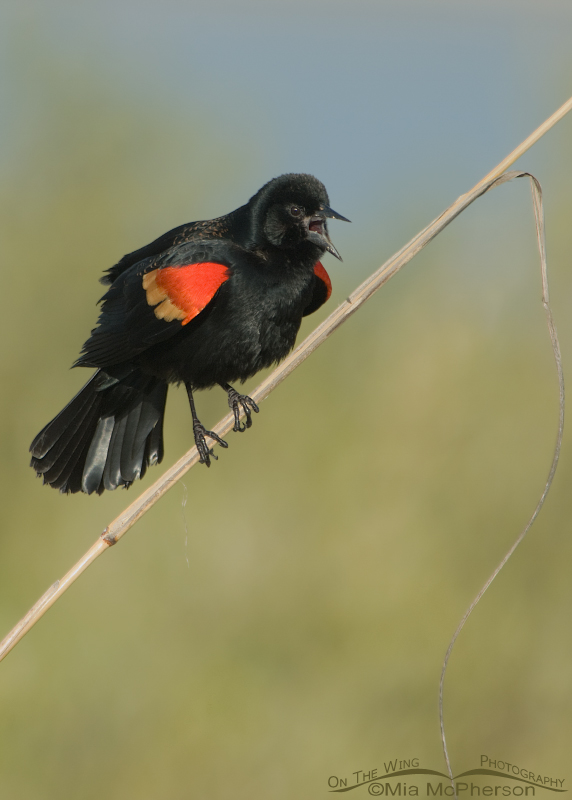 Adult Red-winged Blackbird (Agelius phoeniceus) male singing, Pinellas County, Florida – Nikon D200, handheld, f6.3, 1/640, ISO 250, Nikkor 80-400mm VR at 400mm, natural light
Adult Red-winged Blackbird (Agelius phoeniceus) male singing, Pinellas County, Florida – Nikon D200, handheld, f6.3, 1/640, ISO 250, Nikkor 80-400mm VR at 400mm, natural light
Bye bye Blackbirds
In December of 2010 and January of 2011 the national media outlets reported several mass die offs of birds in the United States. On December 31, 2010 over 5000 blackbirds died and fell on the town of Beebee, Arkansas. On January 4, 2011 near Labarre, Louisiana 500 blackbirds and starlings were reported dead. It was reported that the mass die off in Arkansas was caused by illegal fireworks going off which startled the blackbirds into flying at night, smashing into objects because of their poor night vision.
The USDA is killing birds with DRC-1339
Recently the USDA accepted responsibility for a smaller die off in South Dakota which brought to light a little known program called “Bye bye Blackbird” which uses DRC-1339, a poison that is also called an avicide. I didn’t see this program brought to national attention in the evening news.
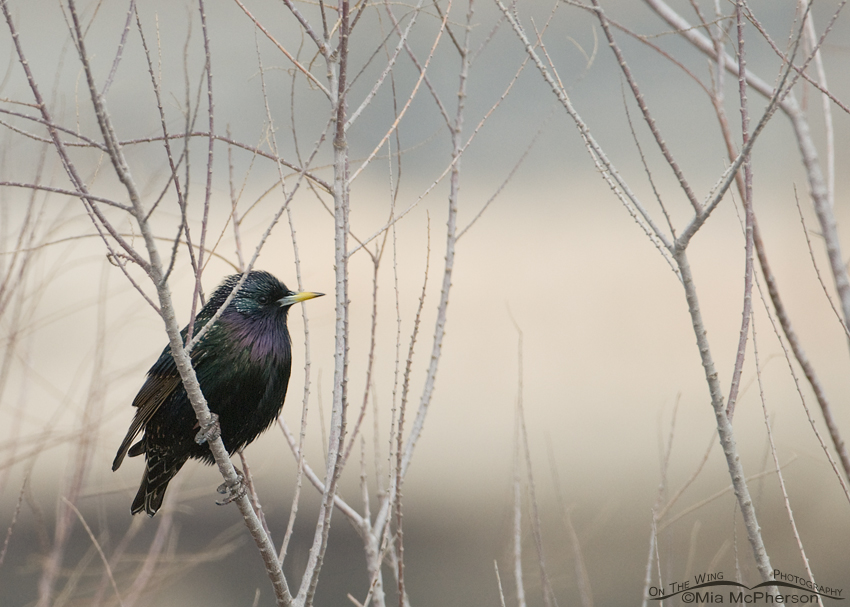 Adult European Starling (Sturnus vulgaris) Salt Lake County, Utah – Nikon D200, f5.6, 1/1000, ISO 400, +0.3 EV, Nikkor 200-400mm with 1.4x TC at 260mm, natural light
Adult European Starling (Sturnus vulgaris) Salt Lake County, Utah – Nikon D200, f5.6, 1/1000, ISO 400, +0.3 EV, Nikkor 200-400mm with 1.4x TC at 260mm, natural light
Target Species
Target species of the “Bye bye Blackbird” USDA Wildlife Services program are blackbirds, starlings, grackles, cowbirds, and pigeons.
A bit about European Starlings: Few people in North America like European Starlings, my thoughts on that are not to blame the bird but to place the blame where it belongs with the people who introduced this species in 1890 – 1891 in New York’s Central Park.
It only took 60 years for European starlings to make their way from the Atlantic coast all the way to the Pacific and a mere 100 birds has now been estimated at over 200 million. They do compete with native species for food and nesting cavities.
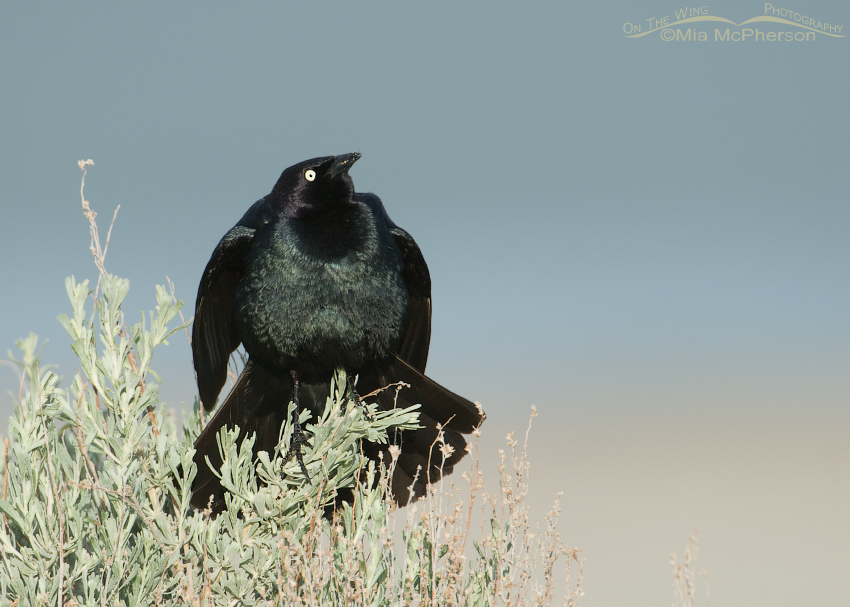 Brewer’s Blackbird (Euphagus cyanocephalus) male singing, Antelope Island State Park, Davis County, Utah – Nikon D200, f7.1, 1/350, ISO 400, -0.3 EV, Nikkor 200-400mm VR with 1.4x TC at 400mm, natural light
Brewer’s Blackbird (Euphagus cyanocephalus) male singing, Antelope Island State Park, Davis County, Utah – Nikon D200, f7.1, 1/350, ISO 400, -0.3 EV, Nikkor 200-400mm VR with 1.4x TC at 400mm, natural light
Of the blackbird target species there are Red-winged Blackbirds, Yellow-headed Blackbirds, Brewer’s Blackbirds, the less common Tricolored Blackbird, and the more rare Rusty Blackbird. The depredation order is currently under review because of the impact it may have on the declining population of the Rusty Blackbird.
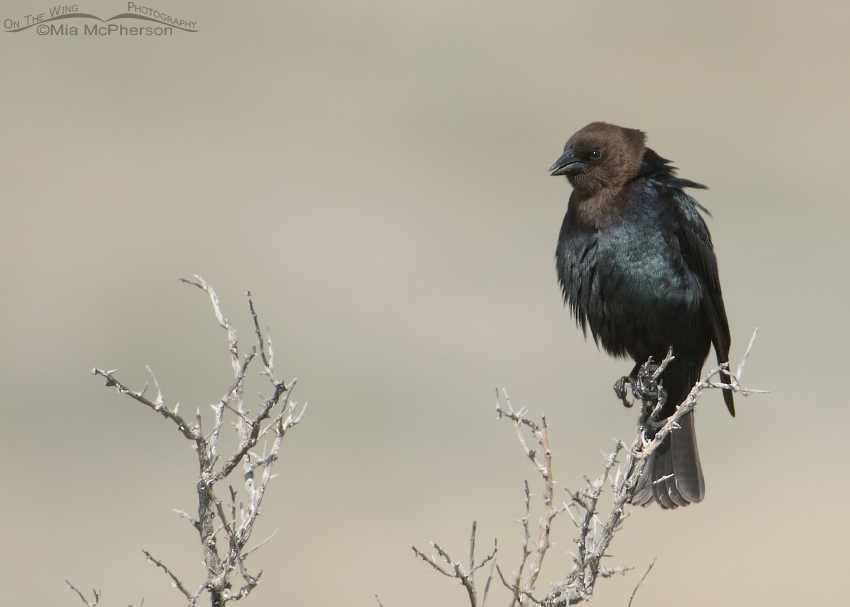 Brown-headed Cowbird (Molothrus ater) male, Antelope Island State Park, Davis County, Utah – Nikon D200, f6.3, 1/640, ISO 250, +0.3 EV, Nikkor 200-400mm VR with 1.4x TC at 400mm, natural light
Brown-headed Cowbird (Molothrus ater) male, Antelope Island State Park, Davis County, Utah – Nikon D200, f6.3, 1/640, ISO 250, +0.3 EV, Nikkor 200-400mm VR with 1.4x TC at 400mm, natural light
Cowbirds are also targeted by the Bye bye Blackbird program, there are 3 species which can be affected, Brown-headed Cowbirds, Shiny Cowbirds and Bronzed Cowbirds. Brown-headed Cowbirds can be found throughout most of North America while the Shiny and Bronzed Cowbirds are more localized to certain geographical areas.
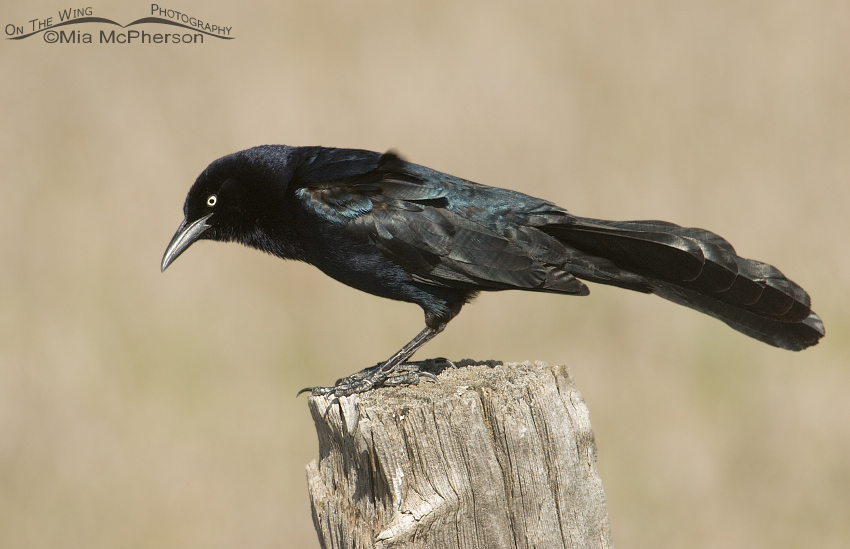 Great-tailed Grackle (Quiscalus mexicanus) male, Farmington Bay WMA, Davis County, Utah – Nikon D200, f7.1, 1/640, ISO 400, Nikkor 200-400mm VR with 1.4x TC at 400mm, natural light
Great-tailed Grackle (Quiscalus mexicanus) male, Farmington Bay WMA, Davis County, Utah – Nikon D200, f7.1, 1/640, ISO 400, Nikkor 200-400mm VR with 1.4x TC at 400mm, natural light
There are three grackle species that are also targeted by the “Bye bye Blackbird” program, Common Grackles, Boat-tailed Grackles and Great-tailed Grackles. Common Grackles cover the largest geographical area, Great-tailed Grackles are found throughout the southwestern United States while Boat-tailed Grackles seem to prefer being along the east coast.
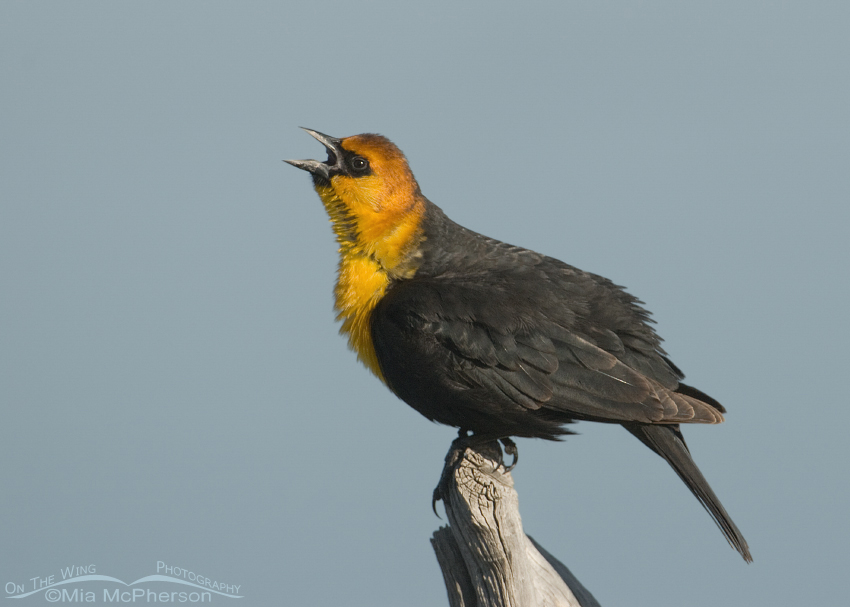 Adult male Yellow-headed Blackbird (Xanthocephalus xanthocephalus) male singing, Farmington Bay WMA, Davis County, Utah – Nikon D200, f7.1, 1/800, ISO 400, +0.7 EV, Nikkor 200-400mm VR with 1.4x TC at 400mm, natural light
Adult male Yellow-headed Blackbird (Xanthocephalus xanthocephalus) male singing, Farmington Bay WMA, Davis County, Utah – Nikon D200, f7.1, 1/800, ISO 400, +0.7 EV, Nikkor 200-400mm VR with 1.4x TC at 400mm, natural light
Why was the USDA Wildlife Services “Bye bye Blackbird” program started and when did it begin?
It began in the 1960’s and became a part of the USDA later. The program was started to aid farmers, dairy farmers and ranchers in the reduction and removal of avian “pests”. Dairy farmers say that a large flock of starlings or blackbirds can eat 200 pounds of feed a day and that their feces can spoil the feed.
Through the Wildlife Service there is a “depredation order” which allows anyone kill blackbirds, starlings or grackles who claims they pose health risks or economic damage. Some areas of the country require permits but farmers are often able to hire private contractors who don’t need to report their bird culls to any authority.
USDA agents killed more than 4 million starlings, blackbirds, grackles and cowbirds in 2009.
“Every winter, there’s massive and purposeful kills of these blackbirds,” says Greg Butcher, the bird conservation director at the National Audubon Society. “These guys are professionals, and they don’t want to advertise their work. They like to work fast, efficiently, and out of sight.”
I have to wonder:
* Why aren’t the farmers required to cover the feed they say is being lost daily or annually?
* Would the birds even be there if the feed was covered?
* Would the birds be defecating on the feed if the feed were covered?
* Why should this program to exterminate these species be paid for by the government?
* What are the effects on non-target species who eat seeds?
* What are the effects on raptors who may ingest the poisoned birds?
* What are the long-term effects of DRC-1339 on humans and the environment?
* How many other birds are dying because of DRC-1339 that we don’t know or hear about?
The USDA says that DRC-1339 does not affect livestock, pets or humans but they didn’t think that DDT would cause the well documented problems for birds that it did. How many times has the USDA or FDA said that a poison or medication wouldn’t be harmful only later to have to recant those statements because it was harmful? How many government studies have been proven wrong?
From promedmail.org: Known exceptions are owls and felines, with LD’s of about 5 mg/kg placing them in the sensitive category.
Last I checked felines included a well known family pet, the cat. And owls are protected.
DRC-1339 causes severe renal failure and congestion to the bird’s major organs, does that sound humane? I don’t think so.
What is next?
* If a Golden or Bald Eagle takes, kills and ingests a lamb or a calf will they be on the Bye bye Blackbird hit list too? They would be causing economic damage.
* Who is watching the private contractors to make sure they are “dosing” the target species safely if they don’t have to report to authorities?
* Why are the private contractors not required to report the number of birds (or species for that matter) to government authorities?
I’d hate to think that our great-grandchildren won’t ever know the sound of a Red-winged Blackbird singing on a spring morning. There needs to be more transparency & accountability about the “Bye bye Blackbird” program.
I’m really bothered by the USDA Wildlife Services Bye bye Blackbird program, are you?
Mia
Click here to see more of my blackbird photos.
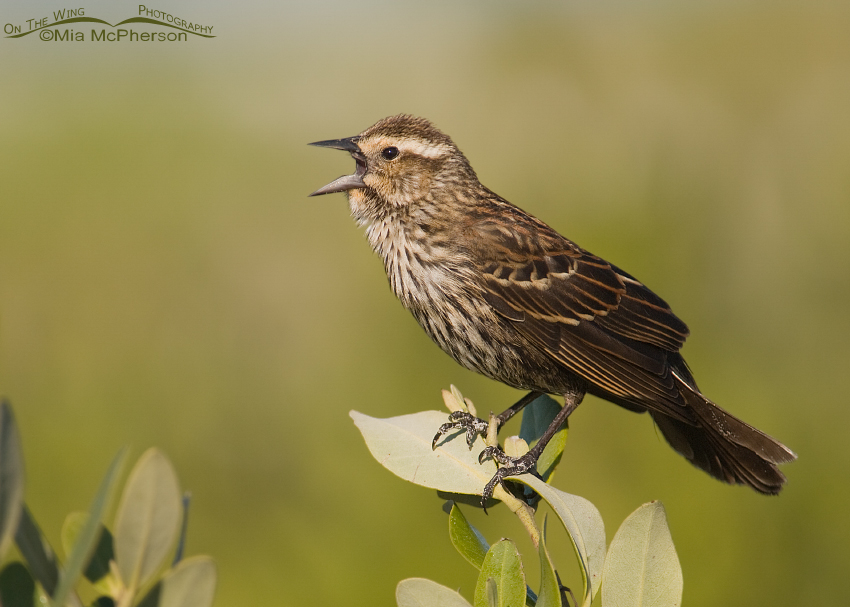 Juvenile male Red-winged Blackbird (Agelius phoeniceus) singing, Pinellas County, Florida – Nikon D200, f6.3, 1/800, ISO 200, Nikkor 80-400mm at 400mm, natural light
Juvenile male Red-winged Blackbird (Agelius phoeniceus) singing, Pinellas County, Florida – Nikon D200, f6.3, 1/800, ISO 200, Nikkor 80-400mm at 400mm, natural light


That is a very upsetting read Mia. I hope the program has stopped. We have a program in Australia that targets Common Mynas. Individual property owners set species’ specific traps and humanely kill the birds on a relatively small scale. I have friends who do this, I can’t but having seen mynas chase Crimson Rosellas from a nesting hollow I understand why they do.
I just now saw this post, Mia. I learned about this program during that recent die-off. Previously, I’d been unaware even though I knew blackbirds were poisoned in the context of agriculture. As you might imagine, I share your views on this. I try to keep my head above it all, but sometimes it’s difficult to retain equanimity about wildlife issues when there are just so many human-originated assaults on our fellow earthlings.
Ingrid, I was very unaware until I wrote this post the numbers of Blackbirds being killed by the use of this poison. I have to wonder how many other species of birds are being killed by DRC-1339 that are not being counted. There are a lot of seed eating birds. It is sad what we humans do to other life forms.
Very sad and it just does not make any sense. Why don’t they cover their feed? Why don’t they…. well there are many other options that make more sense than mass killings. Thanks for posting this.
P.S.
For a link to the total number, by species, of animals killed by Wildlife Services in 2009, see here:
http://www.aphis.usda.gov/wildlife_damage/prog_data/2009_prog_data/PDR_G_FY09/Basic_Tables_PDR_G/Table_G_FY2009_Short.pdf
And for links to totals for other years, see this link, and click on the other years.
http://www.aphis.usda.gov/wildlife_damage/prog_data/prog_data_report_FY2008.shtml
“Highlights” from 2009 included 965,889 Red-winged Blackbirds, 81,684 coyotes, 593 Red-tailed Hawks, and 336 mountain lions.
Hey Mia… not sure if you have heard of the euphemistically named government agency “Wildlife Services” (formerly “Animal Damage Control”).
What wildlife “services” might they provide, you ask? Why, killing any wildlife that farmers and ranchers find undesirable. A big focus is on predators, but they kill huge numbers of blackbirds and starlings too. It is under the auspices of the USDA, so this is probably the agency doing the things you’ve mentioned.
All funded by our tax $$….
Very interesting. I hadn’t heard of such a program either. Reminds me of the bounty on bald eagles in Alaska in the 1900s due of their supposed interference with the salmon industry. It’s frightening what we will do in the name of industry.
It also brought to mind a line from Terry Tempest Williams’ “Refuge” which I particularly like: “When I’m out at the dump with starlings, I don’t want to like them. They are common. They are aggressive, and they behave poorly, crowding out other birds… Perhaps we project on starlings that which we deplore in ourselves: our numbers, our aggression, our greed, and our cruelty. Like starlings, we are taking over the world.”
Thank you for the informational and insightful post.
Interesting post Mia. I had never heard of this government sanctioned effort to kill off blackbirds and some of their allies. I share many of the concerns that you do. There’s many things in this equation that just don’t make much sense and they do raise my suspicions, on several levels.